11.5 Tunnel Solutions, Cascaded BDAs
One way to design a tunnel system with radiating cable is to use daisy-chained BDAs to ‘ramp up’ the signal at certain intervals (Figure 11.9) in order to compensate for the longitudinal attenuation and to keep the coverage level above the required design level. In this type of application the gain of the BDAs will typically be adjusted in order to compensate for the longitudinal loss of the preceding cable, but not higher – that would just cause noise build-up and degraded dynamic range (see Chapter 7 for noise calculations).
Figure 11.9 Radiating cable fed using in-lineBDAs (cascaded system), and the corresponding RF signal

This design methodology is sometime referred to as ‘zero loss systems’.
11.5.1 Cascaded Noise Build-up
Concerns with these types of system with cascaded amplifiers are noise increase and limitations in dynamic range. You will need to be careful when configuring the gain of the amplifiers in the system. This is because each amplifier will amplify the signal and the noise of the preceding link and also add its own noise figure to the performance. If you are not careful there will be a severe cascaded noise build-up in the system. Noise calculations and guidelines on how to design amplifier systems and control the noise are covered in Chapter 7. In practice, you should, at a maximum, cascade three or four BDAs, but this has ...
Get Indoor Radio Planning: A Practical Guide for GSM, DCS, UMTS, HSPA and LTE, Second Edition now with the O’Reilly learning platform.
O’Reilly members experience books, live events, courses curated by job role, and more from O’Reilly and nearly 200 top publishers.

